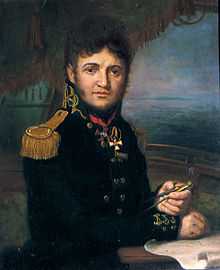Yuri Lisyansky
| Yuri Lisyansky | |
|---|---|
 Portrait of Lisyansky by Vladimir Borovikovsky. | |
| Born |
August 13, 1773 Nizhyn, Russian Empire |
| Died |
March 4, 1837 (aged 63) Saint Petersburg, Russian Empire |
| Allegiance |
|
| Service/branch |
|
| Battles/wars | Russo-Swedish War (1788-1790), Battle of Sitka 1804 |
| Awards | Order of Saint Vladimir |
Yuri Fyodorovich Lisyansky (also spelled as Urey Lisiansky and Lisianski and Lysyansky) (Ukrainian: Юрій Федорович Лисянський Jurij Fedorovyč Lysjanskyj; Russian: Ю́рий Фёдорович Лися́нский Jurij Fëdorovič Lisjanskij, 13 August 1773 – 6 March 1837) was an officer in the Imperial Russian Navy and explorer of Ukrainian origin.
Lisyansky was born in Nizhyn (now Ukraine, then Russian Empire) in the family of the orthodox priest and was a descendant of old Cossack family. In 1786 he graduated from the Navy Cadet Corps and took part in the Russo-Swedish War (1788-1790). During 1790-1793 he served in the Baltic Fleet. During 1793-1799 he sailed British ships all over the globe. Between 1793 and 1795 he served as a volunteer aboard the 36-gun HMS Oiseau, under her captain, Robert Murray. Lisyansky recalled in his memoirs his experiences on the North American Station operating against French convoys and privateers, and how while in the West Indies he was struck by yellow fever, recalling how Murray had helped his recovery, even giving up part of his own accommodation for the sick Lisyansky.[1]
In 1803-1806 Lisyanski as the commanding officer of the Russian-American Company's merchant sloop Neva took part in the first Russian circumnavigation of the Earth. The expedition was under the command of Krusenstern in Nadezhda. They started from Kronstadt, but the ships split after visiting Hawaii, and Lisianski headed to Russian America (Alaska). In 1804 Neva visited Easter Island,[2] and later that year, was essential in defeating the Tlingit in the Battle of Sitka, Alaska. In 1805 he met Krusenstern again in Macau, but they soon separated. Also in 1805, he was the first to describe the Hawaiian monk seal on the island which now bears his name.[3] Eventually, Neva was the first to return to Kronstadt on 22 July 1806. For his feats Lisyanski received several rewards, including the Order of Saint Vladimir of 3rd degree.

Lisyanski was buried at Tikhvin Cemetery of the Alexander Nevsky Monastery, St. Petersburg.
Memorials
A number of places are named after him: Lisianski Island in the Northwestern Hawaiian Islands, a peninsula of Baranof Island, Alaska, a bay, a strait, a river, and a cape in North America, an undersea mountain in Okhotsk Sea, and a peninsula by the Okhotsk Sea.
Citations
- ↑ Lisyansky. A Voyage Round the World in 1803, 4, 5 & 6 ... in the Ship Neva. pp. xvii–xviii.
- ↑ Katherine Routledge refers to page 58 of his book "Voyage round the world in the Ship Neva Lisiansky", London 1814.
- ↑ Monachus Guardian
References
- Lisyansky, Yuri (1814). A Voyage Round the World in 1803, 4, 5 & 6 in the Ship Neva. London: Longman, Hurst, Rees, Orme, and Brown.
- Naming of Alaska